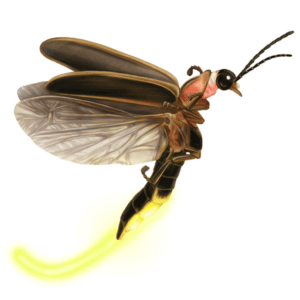Observation: Photinus knulli
Primary Observer:
Joe Cicero
Event Date:
2023-08-18
Status:
Unreviewed

Survey
Site Name:
Tumacacori National Historical Park (TNHP) and adjacent sites associated with the SantaCruzRiver (SCR), AZ
Province/State:
Arizona
Event Date:
2023-08-18
Time of Day:
Night-Time
Start Time:
21:00
End Time:
23:00
Number of Observers:
dozens of personally hosted patrons, post-public viewings
Primary Observer:
Joe Cicero
Additional Observers:
Joe and guests
Julius Schlosburg and guests
Target Species Genus:
Photinus
Target Species Species:
knulli
Location and Habitat
Location Accuracy (meters):
500-1000
Habitat Type:
Riparian - Areas Along lake or stream
Habitat Type Notes:
cottonwood/willow bi-lane and associated mesquite bosque paralleling it.
Elevation (meters):
5700'
Area Searched (hectares):
fallow field (31.567664, -111.048382); Orchard (31.569058, -111.049243); 'cul-de-sac'= oblong area just before reaching SCR (31.569506, -111.046005); SCR just east of latter (31.569489, -111.045400); deAnzaTrail 10min S of Santa Gertrudis (31.561629, -111.046816)
Artificial Light Sources
Vehicles: No
Street Lights: Yes
Buildings: No
collective Nogales/RioRico lights
Street Lights: Yes
Buildings: No
collective Nogales/RioRico lights
Artificial Light Types
Sky Glow (diffuse illumination in the sky): Yes
Light Trespass (light cast on surfaces beyond its intended target): No
Glare (bright light causing visual discomfort): No
Light Trespass (light cast on surfaces beyond its intended target): No
Glare (bright light causing visual discomfort): No
Artificial Light Notes:
overcast clouds serve to badly reflect the city lights; clear, crisp nights were not experienced. Heavy rains preceded dark, and wind dried most vegetation out before waning itself....wind was not an appreciable factor most of the time because of the canopy.
Observation
Observation Type:
Flashing
Number Observed:
50+
Genus:
Photinus
Species:
knulli
Observation Notes:
Specimen Voucher Number:
Flash Behavior
First Flash Time:
21:00
Last Flash Time:
23:00
First Flash Temp (F):
n/a
Last Flash Temp (F):
n/a
Flashes in Pattern:
3
Flash Color:
Yellow
Flash Pattern Period:
n/a
Flash Duration:
n/a
Flash Interval:
n/a
Male Height Zone:
Moderate (3-8 ft)
Flash Location:
see below
Male Flash Behavior:
In 1983, Cicero identified three periods in the waxing and waning of the species, Maturation, Climax, and Decline. These notes document the most important observations, i.e., those that summarize Climax activity, which were taken on 18-20 August '23, on the four sites known to have held the highest density in the TNHP area since initiation of observations by T. Palmer in 1921.
The orchard and fallow field showed relatively negligible numbers during all three periods, but significantly, at the onset of Maturation, the orchard presented the first emergers of the year indicating that eggs were laid there last year. Emergences must have also occurred elsewhere certainly, but these localities weren't given daily observation as was the orchard during public viewings held by the TNHC staff (17-24 July).
The cul-de-sac, SCR, and the deAnza trail S of Santa Gertrudis, presented the best behavioral observations of all during the August 18-21 dates and, since the season is nearing its end, are therefore considered Climactic. Each location showed ground-to-ground synchrony, ground-t-o-air synchrony and short-lived, mid (1-2 yards)- to long ( 3-5 yards) distance entrainment. These male-male communications did not consummate in a lek- they did not contract into a well defined arena with coherent flash exchanges as described in Cicero (1983), but they did indicate the potential to do so if only the ff were to settle into optimum surface structure to facilitate such interactions. Tall grass and weeds, rough ground with rocks and fallen branches, moon, Nogales lights, and many other itemizable impediments and suppressing factors were present. There were areas with what is estimated to have optimum structure based on the 1983 arena, such as the northwest corner of the orchard, and the S.Gertrudis site, but for reasons unknown, congregations did not ensue. Next year, 2024, we must marshall our efforts into running experiments designed to foment lek formation so that we can document by video the escapades within.



